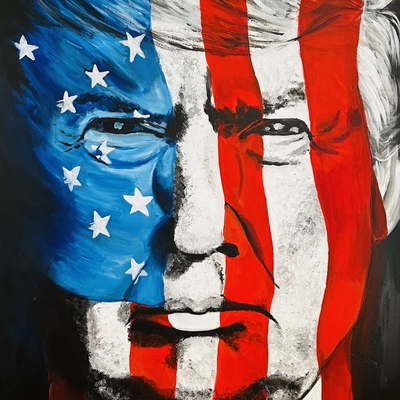Stay informed on the latest Truth Social posts from Donald Trump (@realDonaldTrump) without the doomscrolling. Consider it a public service for your mental health. (Why?)
- Digital Taxes, Digital Services Legislation, and Digital Markets Regulations are designed to harm or discriminate against American Technology.
- These regulations give a complete pass to China's largest Tech Companies.
- These discriminatory actions must end immediately.
- As President, Donald J. Trump will impose substantial additional Tariffs on that Country's Exports to the U.S.A. if discriminatory actions are not removed.
- As President, Donald J. Trump will institute Export restrictions on Highly Protected Technology and Chips if discriminatory actions are not removed.
- America and American Technology Companies will no longer be exploited as the 'piggy bank' or 'doormat' of the World.
- Countries must show respect to America and its Technology Companies or consider the consequences.
The post directly targets 'American Tech Companies' and threatens 'substantial additional Tariffs' on foreign exports to the U.S.A., along with 'Export restrictions on our Highly Protected Technology and Chips.' These proposed policies, if enacted, would directly impact the revenue, profitability, and supply chains of major U.S. technology and export-oriented companies. The threat of global trade friction and potential retaliatory tariffs from other nations would introduce significant uncertainty into the market, likely leading to increased volatility and potential downward pressure on the S&P 500, particularly for the tech sector.
The post issues a clear ultimatum, threatening significant economic retaliation (tariffs and export restrictions) against countries that maintain certain digital taxes and regulations perceived as discriminatory. This elevates trade tensions and could lead to retaliatory measures from targeted nations, increasing diplomatic friction and the likelihood of trade disputes. While direct military conflict is not mentioned, the aggressive economic posture could strain international relations.
- Commodities: Gold (XAU) is likely to rise due to increased geopolitical and trade uncertainty, acting as a safe-haven asset. Oil (WTI) may face downward pressure from fears of global economic slowdown induced by trade disputes, but supply-side concerns could arise from broader geopolitical shifts. Industrial metals like Copper might fall on reduced global growth expectations. Short-Term Watchlist: XAU/USD price action, oil inventory reports, headlines on trade negotiations/retaliation. Medium-Term Focus: Global growth outlook, inflation trends if tariffs increase import costs, USD trajectory.
- Currencies (Forex): The US Dollar Index (DXY) could strengthen as a safe-haven currency amid global uncertainty, or potentially weaken if trade conflicts are perceived to significantly harm the U.S. economy. Currencies of countries targeted by tariffs would likely weaken. Short-Term Watchlist: DXY movements, EURUSD, USDJPY, AUDUSD (as a proxy for global trade sentiment). Medium-Term Focus: Central bank policy divergence, global trade balances, and capital flows responding to policy changes.
- Global Equities: S&P 500 and Nasdaq are likely to face downward pressure due to potential earnings risks for U.S. technology companies and broader trade uncertainty. European (STOXX 600) and Asian (Nikkei 225, Hang Seng) markets would also be negatively impacted by fears of global trade wars and an economic slowdown. Sectors with significant international exposure, especially tech and manufacturing, would be most affected. Short-Term Watchlist: Futures open, VIX spike/dip, performance of FANG/semiconductor stocks. Medium-Term Focus: Corporate earnings revisions, global macroeconomic data (PMIs), and capital flow adjustments.
- Fixed Income (Bonds): US 10Y and 2Y yields are likely to fall as investors seek safe-haven assets (flight to safety), increasing bond prices. This could lead to a flattening of the yield curve. Credit spreads may widen if corporate profitability is squeezed by tariffs and trade uncertainty. Short-Term Watchlist: UST 10Y yield levels, TED spread, credit ETF flows. Medium-Term Focus: Inflationary pressures from tariffs, potential Federal Reserve policy responses to trade-induced economic slowdowns, fiscal concerns.
- Volatility / Derivatives: The VIX is highly likely to spike due to significantly increased market uncertainty, heightened geopolitical risk perceptions, and the potential for a global trade war. Options positioning would likely reflect increased demand for downside protection across major indices. Short-Term Watchlist: VIX levels versus VIX futures term structure, implied volatility across asset classes. Medium-Term Focus: Shifts in volatility regimes, macro policy uncertainty, and systemic tail risks related to trade conflicts.
- Crypto / Digital Assets: Bitcoin (BTC) could exhibit mixed behavior, potentially acting as a safe-haven asset if traditional markets decline significantly, or behaving as a risk-on asset and selling off alongside equities due to tightening global liquidity. Its correlation with tech stocks suggests initial pressure, but prolonged trade conflict might enhance its perceived value as an alternative store of value. Short-Term Watchlist: BTC/USD price action, correlation with Nasdaq, funding rates. Medium-Term Focus: Macro liquidity backdrop, regulatory developments, and broader risk sentiment.
- Cross-Asset Correlations and Systemic Risk: Increased trade tensions could lead to a breakdown in normal cross-asset correlations, potentially causing equities and bonds to sell off simultaneously (risk-off across the board). Signs of liquidity stress or margin calls could emerge if corporate earnings decline significantly due to tariffs. Short-Term Watchlist: MOVE index, junk bond ETFs, gold/USD co-movement. Medium-Term Focus: Potential for broader financial system stress, central bank interventions to stabilize markets, and market plumbing resilience.
- Retail Sentiment / Market Psychology: The post's strong nationalistic and protective language could resonate with retail investors, potentially leading to increased speculation in specific 'patriotic' or 'reshoring' related stocks. Conversely, it could trigger a general increase in risk aversion among retail investors, impacting broader market flows. Short-Term Watchlist: Social media trends (e.g., Twitter/X, Reddit), sentiment indicators related to U.S. tech or trade policy. Medium-Term Focus: Social media influence on market structure, potential for coordinated retail pushes in response to policy, and any regulatory scrutiny of retail trading behavior.

